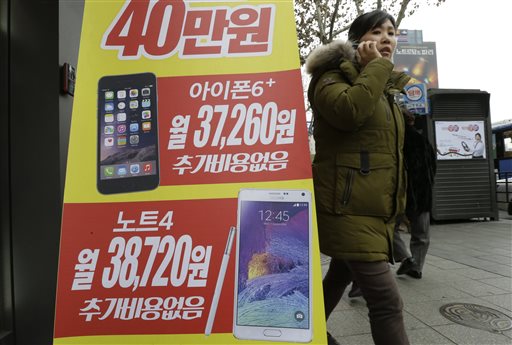
n advertisement poster shows Apple’s iPhone 6 Plus, top, and Samsung Electronics’ Galaxy NOTE 4 at a mobile phone shop in Seoul, South Korea, Thursday, Jan. 29, 2015. Samsung Electronics Co. said Thursday its quarterly earnings dropped smaller-than-expected 27 percent in the fourth quarter but its forecast-beating profit could not mask that it was losing the battle of the big phones with Apple Inc. AP
SEOUL — Samsung lost the battle of the big phones last quarter as Apple’s copycat large iPhone lured buyers in the crucial Chinese market.
The South Korean company said Thursday its profit sank last quarter, with an improvement in its semiconductor business insufficient to mask its mobile problems.
It was in China, the world’s largest market for smartphones, where Samsung’s dramatic decline was most evident.
Samsung accounted for nearly one third of global smartphone sales in 2013, twice as much as Apple. This year, it has dropped to about one quarter.
Apple Inc. was behind Samsung’s latest reversal in fortune, launching iPhones with bigger screens that robbed Samsung’s Galaxy phones of a key selling point. The company was already battling competition in low-end phones from upstart manufacturers such as China’s Xiaomi.
In the second quarter last year, Xiaomi overtook Samsung to become the biggest selling smartphone maker in China. Samsung now ranks third in that market, after Apple raced to the top in the fourth quarter, according to research company Canalys.
Samsung is struggling in countries such as China because “they’re sort of being eaten from the bottom up by regional players” including Huawei and Xiaomi, said Ben Bajaran, an analyst at Silicon Valley research firm Creative Strategies.
“And now with Apple being competitive in larger phones, you’re seeing them Samsung losing any edge they had at the high end,” he said.
Thanks to its bigger iPhones, Apple sold a record 74.5 million iPhones last quarter, which also helped make it the world’s most profitable company.
Samsung, on the other hand, reported its fourth straight drop in quarterly earnings. Profit sank 27 percent to 5.3 trillion won ($4.9 billion).
Until September, Apple lacked one thing that Samsung and other phone-makers had: a supersized smartphone screen. Apple’s older iPhone 5 had a screen that measured 4 inches diagonally, while screens of 5 inches or larger have been the standard in Asia for more than a year. The new iPhone 6 measures 4.7 inches and the 6 Plus is 5.5 inches. And that’s made a huge difference.
Meanwhile, Samsung’s flagship Galaxy S5 smartphone was criticized for a cheap looking design.
Samsung replaced parts of the design with metallic features in subsequent models after the criticism.
In its earnings conference call, Samsung estimated that its worldwide smartphone sales during the quarter were between 72.2 million units and 75.1 million units, confirming analysts’ forecasts that Apple has clawed back Samsung’s lead if not overtaken it.
Samsung’s fourth quarter profit was a moderate improvement from the previous quarter’s 4.2 trillion won and higher than analysts’ forecasts of 4.4 trillion won, according to financial data provider FactSet.
Sales fell 11 percent from a year earlier to 52.7 trillion won while operating profit slumped 36 percent to 5.3 trillion won, in line with Samsung’s preview earlier this month.
The company’s fourth-quarter net income beat forecasts mainly thanks to the solid performance of its component businesses, such as memory chips and display panels. The semiconductor division was a key cash cow generating about half of Samsung’s quarterly operating income.
Samsung didn’t give clear guidance of how its mobile business would perform during the current quarter. Instead to appease investors, the company announced a 40 percent increase in its annual dividends for 2014.
Repeating its previous statements, the company said it will try to differentiate its smartphones with new materials and designs and will reduce the number of smartphone models to streamline its business.
Samsung has introduced the Galaxy Note Edge, the big-size smartphone with a curved side display, but it remained a niche product. Output of curved screens remains limited until a new production line goes into operation later this year.
The company is expected to unveil an update to its flagship Galaxy S smartphone in the spring.
RELATED STORY
After setting iPhone record, what does Apple do next?